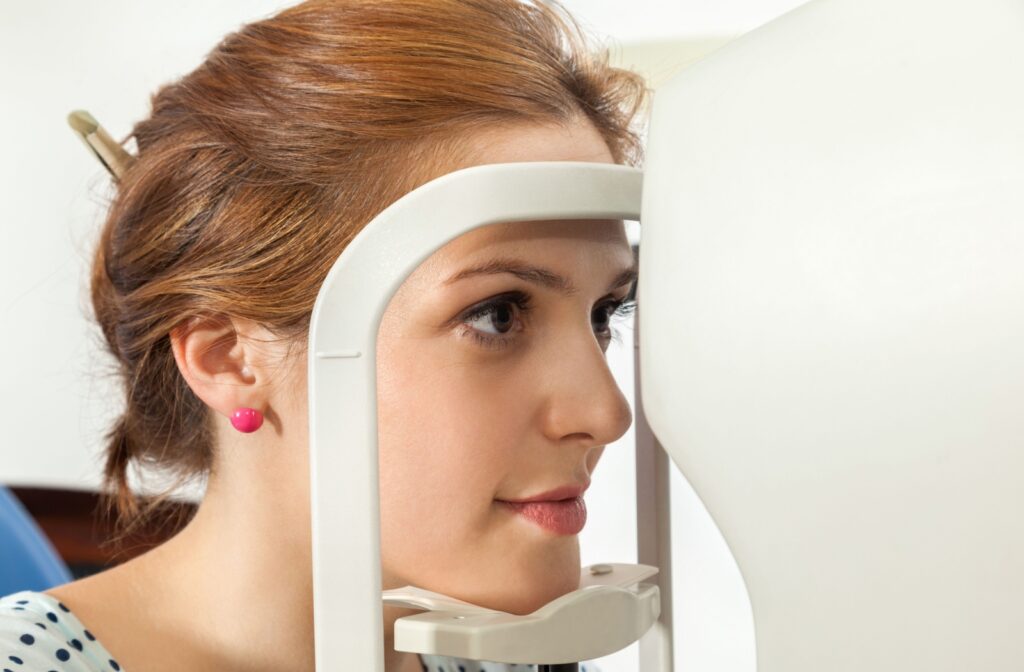Your vision is more than just what you see directly in front of you. It’s the entire picture, from the words on this page to the movement you catch at the edge of your sight. This complete view helps you navigate the world safely and thoroughly, but you may not always notice when parts of it start to fade. That’s why regular eye health evaluations are so important.
A visual field test helps your eye care team map out your entire range of vision to find any changes you might not see on your own. It’s a noninvasive procedure that measures your central and peripheral vision to detect blind spots. This test, during an eye exam, gives us a detailed look at how your eyes and brain are working together to process what you see.
What This Test Shows About Your Vision
Think of a visual field test as creating a map of your sight. It charts what you can see up, down, left, and right while your eyes are focused on a single point. This process can reveal blind spots, also known as scotomas, in your peripheral vision that might otherwise go unnoticed.
Central and Peripheral Vision
Your vision has 2 main components that work together. Central vision is what you use to focus on details, like reading a text message or recognizing a friend’s face across the room. It’s sharp, clear, and what we use for most direct tasks.
Peripheral vision is everything you see on the sides. It helps you sense motion, navigate through crowds, and avoid obstacles without needing to turn your head. You rely on it for activities like driving, playing sports, or simply walking down a busy street.
Why It’s Part of a Full Eye Exam
We include a visual field test as part of a comprehensive eye exam because it provides important information that other tests may not. According to the American Optometric Association, a complete eye exam can reveal health conditions that vision screenings often miss.
Some eye health conditions can affect your peripheral vision long before you notice any changes to your central sight. By mapping your visual field, we can get a complete picture of your eye health.
How a Visual Field Test Works
The test itself is straightforward and doesn’t involve any discomfort. You’ll look into a bowl-shaped instrument and focus on a light in the center. As you stare ahead, other small lights will flash at different points in your side vision, and you’ll click a button each time you see one. This process follows standard protocols for effective visual field testing:
- You sit comfortably in front of the testing machine with your chin on a rest.
- One eye is covered with a patch, allowing us to test each eye individually.
- You press a button to signal every time a light appears in your field of view.
How Long Does a Visual Field Exam Take?
The test is a quick and efficient part of your eye health assessment. Testing each eye typically takes about 5 to 10 minutes. The entire process is generally completed in under 30 minutes, providing us with valuable information in a short timeframe.
How to Prepare for Your Appointment
There isn’t much you need to do to prepare for a visual field test. The most important thing is to arrive at your appointment feeling rested and ready to focus. If you feel tired during the test, just let the technician know; we can always pause for a short break.
Do Your Eyes Have to Be Dilated for a Visual Field Test?
Eye dilation is not always required for a visual field test. Whether your eyes need to be dilated depends on the other components of your comprehensive exam. A dilated pupil allows your eye care professional to see the back of your eye, so they will discuss the plan for your visit and let you know what to expect.
Can I Drive After a Visual Field Test?
You can typically drive yourself home after a visual field test. However, if your eyes are dilated for other parts of your exam, your vision may be blurry and sensitive to light. In that case, we recommend arranging for someone to drive you home for your safety.

Understand Your Test Results
After you complete the test, your eye doctor will review the map of your vision with you. The results show a pattern of the points you saw and those you missed. We’ll sit down together and discuss what these results mean for your eye health.
What It Means to Have an Abnormal Result
An abnormal result simply indicates there are areas in your peripheral vision where you didn’t see the light flashes. This doesn’t automatically point to a serious problem, as results can be affected by fatigue or a brief lapse in concentration.
However, it can also be an early indicator of certain eye and health conditions, showcasing the full picture of your health that an eye exam can reveal. Some examples include:
- Glaucoma
- Stroke
- Other optic nerve conditions
Next Steps After an Abnormal Test
If your results show any areas of concern, we’ll discuss the next steps together. Sometimes, we may recommend repeating the test on another day to confirm the findings. Other times, we might suggest further diagnostic tests to get a clearer picture of what’s happening.
The Role of Visual Field Tests in Preventive Eye Care
Regular visual field testing is a key part of proactive and preventive eye care. It helps us track your vision over time and detect subtle changes before they can impact your daily life. An early-detection approach gives us the best opportunity to protect your sight for the long term. Your eye doctor can use these results to develop a personalized care plan tailored to your specific needs.
Protecting your sight is about seeing the whole picture, not just what’s right in front of you. A visual field test is a simple yet powerful tool that helps us do just that. To support your long-term eye health, schedule a comprehensive eye exam with us at Total Vision Fountain Valley today.



